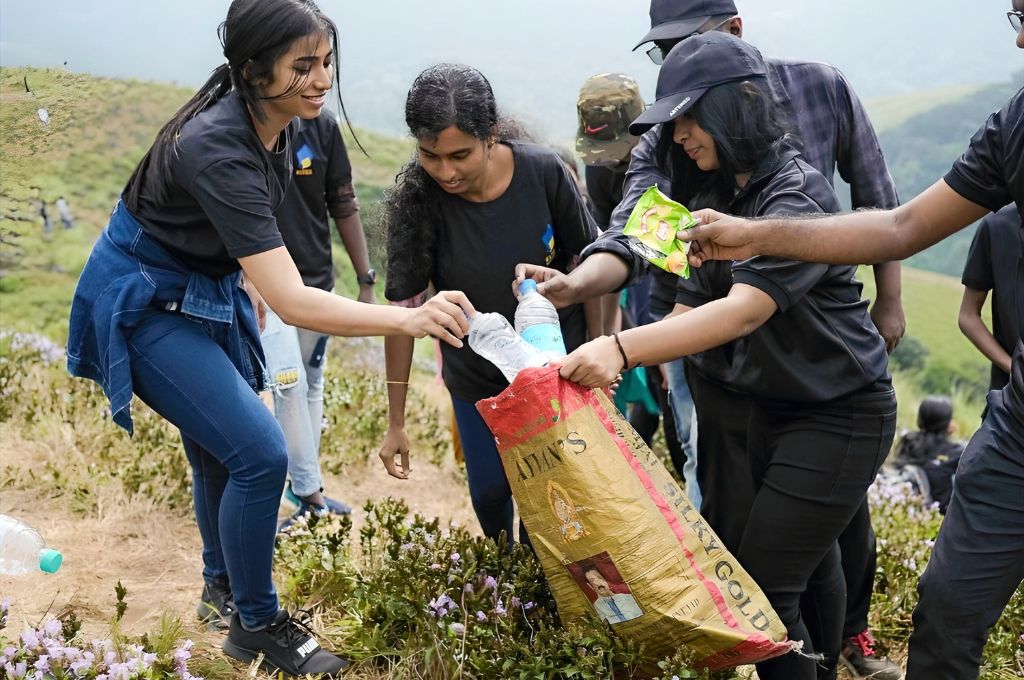Volunteering typically peaks in times of crisis. Impelled by the urgency of a disaster, the intensity of its news coverage, and widespread appeals for help, people step forward with funds and services, willingly and immediately. And yet India grapples with a steady stream of civic, social, and environmental crises that need attention and support throughout the year. This is because these long-standing problems—poverty, human trafficking, and mental health crises—often struggle to garner sustained public support.
It is the development sector that shoulders much of this work, raising and routing funds and human resources for the range of simmering problems the sector attempts to solve. But nonprofit resources are often limited and bound by red tape. India’s social sector has fewer than 10 lakh civil society organisations (CSOs), and only 11–12 percent of these are active (according to the Between Binaries report published last year by Centre for Social and Economic Progress). This means there is one active CSO for 11,000–12,000 people. In the poorest districts, this ratio could plummet to one organisation for a population of 25,000–50,000.
To make matters worse, the funding crunch that the sector is witnessing on account of legislative changes in the Foreign Contribution Regulation Act (FCRA) has resulted in staff downsizing and even closure, with hard-hitting consequences on service delivery. In light of these constraints, can nonprofits in India find alternate ways to sustain their programmes? Can a committed volunteer base help keep the engine running?

Where do volunteers fit in
While volunteers cannot replace trained social sector workers nor replicate their skills developed over years on the field, they can contribute significantly—and often in unexpected ways—to a nonprofit. But nonprofits don’t always see it this way. They fail to engage volunteers meaningfully in their work, or for an appreciable length of time, and this stems from a lack of vision for the role a volunteer can play in an organisation.
Nonprofits often look at volunteers as only a provisional resource for menial tasks such as helping with an event or conducting a survey—a stopgap that can be easily replaced with someone else. Sometimes, volunteers are not valued enough for their efforts or are treated discourteously. Disappointed, they may choose not to volunteer with the organisation again, costing the organisation an opportunity to build an army of allies for the long term (a devoted volunteer may later bring their family and friends along too).
Volunteer engagement requires dedicated effort, creative thinking, fierce networking, and strategic planning.
Some nonprofits, such as those involved in anti-trafficking operations or juvenile rehabilitation, undertake highly specialised and sometimes risky work that demands specific skills and long-term commitment. These organisations need volunteers too, but fear that inconsistency or complacency on the part of the volunteer could endanger the work. For example, an anti-trafficking nonprofit might need someone (who is unfamiliar with trafficking and policing and unknown to the sector’s circles) to act as a decoy customer to bait a trafficker—an assignment that would require long and rigorous training. Nonprofits often don’t know where to find volunteers for these missions.
In our experience, nonprofits haven’t yet discovered the true value a volunteer can bring to the table. Volunteer engagement requires dedicated effort, creative thinking, fierce networking, and strategic planning. It was to bring these resources to the table and connect nonprofits to volunteers in new and sustainable ways that The Movement India was set up in 2017. We are a platform that deploys citizens in volunteering opportunities in three social sectors: education, mental health, and anti-human trafficking. Our aim is to help nonprofits meet their short- and long-term goals and enable volunteers to find a sense of purpose through enriching experiences.
Here are some of the techniques and approaches we have adopted.
1. Engage volunteers affiliated with existing volunteer bodies
Nonprofits looking for volunteers can consider the National Service Scheme (NSS), a central sector scheme that enables school, college, and university students to participate in community service. Each student member is awarded a certificate on completion of 120 hours of service a year. Approximately 10–30 of these hours can be reserved for nonprofit work; the rest are earmarked for central and state-level social initiatives.
At present, 39 lakh students are enrolled in NSS units across the country. This is a substantial pool of human resources that nonprofits can tap. Working with CSOs also allows students to engage in varied and exciting projects, apart from the mandated beach clean-ups and tree-plantation drives. When young volunteers are co-opted into activities that excite them, volunteerism becomes more than just a certificate-centric task; it cultivates a sense of purpose and fosters social consciousness. These objectives also align with the spirit of the NSS, which aims to raise legions of socially responsible citizens in the country.
Volunteers can be found within large residential societies, schools, clubs like the Rotary, the National Cadet Corps, and religious institutions too. Nonprofits simply have to reach out to them. They can alternatively turn to volunteer aggregation platforms such as The Movement India, Chezuba, Goodera, ConnectFor, and ThoseinNeed that draw on these very resources, saving nonprofits the trouble of approaching volunteers directly and negotiating volunteering terms with them.
2. Craft a strong pitch
In 2018—around the time Kerala was witnessing widespread floods—our team was out recruiting volunteers at St Andrew’s college in Mumbai. The principal told us it was going to be a hard sell. “I don’t think anyone is going to be interested; they’re already busy with classwork and internships,” she warned us. We often encounter such reluctance, and the way to overcome it is to build a strong pitch for our cause.
One thing that organisations can do is convince citizens about the cause more compellingly.
And so, we started our conversation with the students with a simple question: What’s everybody talking about these days? “The Kerala floods,” they shouted. We then asked them, “How many people have been affected by the floods?” They all made their guesses. Approximately 1 million, we confirmed. We prodded further, “Do you know of a problem that is eight times bigger, but that no one talks about?” This immediately grabbed their attention. They all wanted to know what the problem was. We said if they were keen to learn about it, they should sign up for the seminar we were going to conduct in their college. Three times the expected number of students turned up. The subject we were referring to was human trafficking in India. Getting people’s attention is half the work.
St Andrew’s college is now one of our top volunteer bases. We have even been invited to pitch volunteering as a mental well-being exercise during the induction and orientation of new batches there, and at other colleges such as Mithibai in Mumbai.
Nonprofits looking to build support for a campaign or a cause are often met with pushback and told, “People don’t care; what are you going to do about it?” One thing that organisations can do is convince citizens about the cause more compellingly.
Unfortunately, many nonprofits struggle to articulate their value proposition, or sometimes the problem itself. Here value proposition refers to highlighting the value in what a nonprofit does and why citizens should care about it. For example, the value proposition of an educational nonprofit is more impactful when worded as, “We free children from exploitation by engaging them in education,” rather than just stating that they provide education for children in slum communities.
Nonprofits also find it hard to tell volunteers what is happening on the ground and what is expected of them. Volunteers need to hear compelling appeals such as “Help us get a child to school this summer. Join the Mission Admission squad!” or “Every form you fill today has the potential to change the future of a child, forever.” The ‘ask’ must be clear and specific.
Good communication is especially indispensable when it comes to causes that people hesitate to volunteer for. We once tried to schedule a volunteering session for corporate employees at a juvenile home, but many shied away from it because they were reluctant to engage with those who were in conflict with the law. In such cases, familiarising volunteers with the context of the mission, destigmatising the place, and assuring them of the safety protocols in place can help.
3. Make it easy for volunteers to serve
Many people want to lend their skills to a worthy cause, but not everyone has the time or resources for a big commitment. So, volunteering should be made as flexible and practical as possible. Enable people to volunteer from their homes, for perhaps a few hours a week or month, and refrain from asking for a long commitment upfront.
All organisations have a list of tasks that can be easily performed at home. For example, volunteers can create teaching material and record stories for children on their phones or laptops. They can be roped in for fundraising and to make slide decks, create jingles, run data analytics, write proposals (not every nonprofit has a good proposal writing or fundraising team), or design motifs for nonprofit products—all from the comfort of their own homes. Making it convenient for people to contribute their time and skills is one way to have more of volunteering. Just like tech platforms have benefitted retail giving, technology can be utilised to strengthen volunteering.
Nonprofits can tap additional services this way and build capacity without having to stretch their scant resources. A nonprofit that works with women’s self-help groups can market their products on social media without having to hire a social media marketer. Fashion design students can contribute designs to a small-scale tailoring unit run by vulnerable women.
There’s a lot that can be done even without pressing specialised skills into service. During the pandemic, for example, we had volunteers on phone duty, calling up former prisoners and women rescued from sex trafficking to check on them and remind them of COVID-19 protocols. A simple gesture like this not only helped spread awareness but also made those receiving these calls feel special and valued.
4. Engage with corporate employees
Not every nonprofit can access CSR funds. They may fall short of the company’s criteria for grants, or their proposals may fail to impress corporate decision-makers. Yet, if not money, companies can volunteer the skills and talents of their employees through CSO outreach programmes. They can conduct business skills training for women in skill development programmes, manage large-scale events, conduct online spoken English or content creation classes, or help job candidates polish their interview skills.
All it takes is one employee to convince their teammates to pitch in for a worthy cause.
We once brought a corporate team to a home for survivors of human trafficking. After the employees interacted with the children, we urged them to help raise the visibility of the organisation on LinkedIn by following their page and interacting with their posts, a simple action that would be noticed by their social media contacts. This would help the shelter’s own network grow and improve the likelihood of receiving funding in the long run.
Sometimes, corporate volunteers can help raise funds for the nonprofits themselves, outside their company’s CSR remit. Their familiarity with the nonprofit and its work may even lead employees to recommend the organisation for future funding through formal CSR channels.
When seeking corporate volunteers, CSOs could also consider approaching individual departments within a company if they haven’t had success with the formal CSR route. We’ve experienced that in large organisations, such as Tata Consultancy Services, teams have enough autonomy to take on their own social impact projects; these decisions don’t always sit with higher-ups. Nonprofits could explore opportunities with employees directly. All it takes is one employee to convince their teammates to pitch in for a worthy cause.
5. Set up opportunities for self-reflection
At the end of every volunteering assignment, we ask our volunteers two simple questions: “What did you do?” and “What did you really do?” The first question draws a prompt response, where they recount the tasks they performed as volunteers. A person might say they visited a low-income community and surveyed 15 families. When asked the second question, they start to reflect on what they ‘really’ did. They then begin to appreciate the deeper implications of that action: “I didn’t just conduct a survey, I helped bridge a child’s access to education.”
When volunteers are made to see their role as transformative, it kindles a deeper commitment with the cause and drives them to prolong their engagement with the organisation. The simple truth is, volunteering is as much about helping others as it is about being able to appreciate our skills and talents in a new light and value ourselves in a new way.
The simple truth is, volunteering is as much about helping others as it is about valuing ourselves in a new way. It creates room for us to appreciate our skills and talents in a new light.
—
Know more
- Read this article to learn about emerging trends and approaches in volunteering.
- Read this article to learn more about skill-based volunteering.
Do more
Connect with The Movement India at [email protected] to design a volunteer engagement programme for your organisation.





